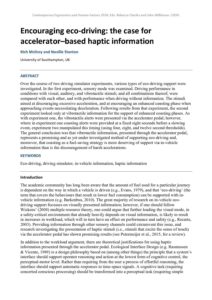| Document | Author Rich McIlroy and Neville Stanton |
| Abstract Over the course of two driving simulator experiments, various types of eco-driving support were investigated. In the first experiment, sensory mode was examined. Driving performance in conditions with visual, auditory, and vibrotactile stimuli, and all combinations thereof, were compared with each other, and with performance when driving without information. The stimuli aimed at discouraging excessive acceleration, and at encouraging an enhanced coasting phase when approaching events necessitating deceleration. Following results from that experiment, the second experiment looked only at vibrotactile information for the support of enhanced coasting phases. As with experiment one, the vibrotactile alerts were presented via the accelerator pedal; however, where in experiment one coasting alerts were provided at a fixed eight seconds before a slowing event, experiment two manipulated this timing (using four, eight, and twelve second thresholds). The general conclusion was that vibrotactile information, presented through the accelerator pedal, represents a promising and as yet under investigated method of supporting eco-driving and, moreover, that coasting as a fuel-saving strategy is more deserving of support via in-vehicle information than is the discouragement of harsh accelerations. |

